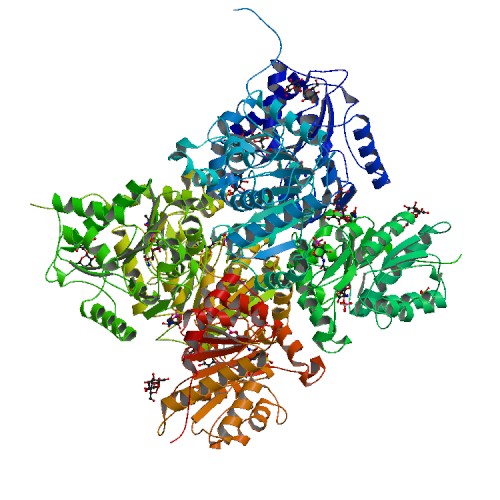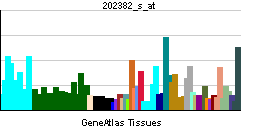GNPDA1
| Glucosamine-6-phosphate deaminase 1 | |||||||||||||
|---|---|---|---|---|---|---|---|---|---|---|---|---|---|
 PDB rendering based on 1ne7. | |||||||||||||
| |||||||||||||
| Identifiers | |||||||||||||
| Symbols | GNPDA1 ; GPI; GNPI; GNPDA; HLN; KIAA0060 | ||||||||||||
| External IDs | Template:OMIM5 Template:MGI HomoloGene: 38054 | ||||||||||||
| |||||||||||||
| RNA expression pattern | |||||||||||||
 | |||||||||||||
| More reference expression data | |||||||||||||
| Orthologs | |||||||||||||
| Template:GNF Ortholog box | |||||||||||||
| Species | Human | Mouse | |||||||||||
| Entrez | n/a | n/a | |||||||||||
| Ensembl | n/a | n/a | |||||||||||
| UniProt | n/a | n/a | |||||||||||
| RefSeq (mRNA) | n/a | n/a | |||||||||||
| RefSeq (protein) | n/a | n/a | |||||||||||
| Location (UCSC) | n/a | n/a | |||||||||||
| PubMed search | n/a | n/a | |||||||||||
Glucosamine-6-phosphate deaminase 1, also known as GNPDA1, is a human gene.[1]
References
Further reading
- Weidanz JA, Campbell P, DeLucas LJ; et al. (1995). "Glucosamine 6-phosphate deaminase in normal human erythrocytes". Br. J. Haematol. 91 (1): 72–9. PMID 7577655.
- Nomura N, Nagase T, Miyajima N; et al. (1995). "Prediction of the coding sequences of unidentified human genes. II. The coding sequences of 40 new genes (KIAA0041-KIAA0080) deduced by analysis of cDNA clones from human cell line KG-1". DNA Res. 1 (5): 223–9. PMID 7584044.
- Oliva G, Fontes MR, Garratt RC; et al. (1996). "Structure and catalytic mechanism of glucosamine 6-phosphate deaminase from Escherichia coli at 2.1 A resolution". Structure. 3 (12): 1323–32. PMID 8747459.
- Wolosker H, Kline D, Bian Y; et al. (1998). "Molecularly cloned mammalian glucosamine-6-phosphate deaminase localizes to transporting epithelium and lacks oscillin activity". FASEB J. 12 (1): 91–9. PMID 9438414.
- Shevchenko V, Hogben M, Ekong R; et al. (1998). "The human glucosamine-6-phosphate deaminase gene: cDNA cloning and expression, genomic organization and chromosomal localization". Gene. 216 (1): 31–8. PMID 9714720.
- Nakamura Y, Miura K, Fujino Y; et al. (2001). "Evolution, structure, and expression of GNPI/Oscillin orthologous genes". Genomics. 68 (2): 179–86. doi:10.1006/geno.2000.6287. PMID 10964516.
- Strausberg RL, Feingold EA, Grouse LH; et al. (2003). "Generation and initial analysis of more than 15,000 full-length human and mouse cDNA sequences". Proc. Natl. Acad. Sci. U.S.A. 99 (26): 16899–903. doi:10.1073/pnas.242603899. PMID 12477932.
- Zhang J, Zhang W, Zou D; et al. (2003). "Cloning and functional characterization of GNPI2, a novel human homolog of glucosamine-6-phosphate isomerase/oscillin". J. Cell. Biochem. 88 (5): 932–40. doi:10.1002/jcb.10444. PMID 12616532.
- Arreola R, Valderrama B, Morante ML, Horjales E (2003). "Two mammalian glucosamine-6-phosphate deaminases: a structural and genetic study". FEBS Lett. 551 (1–3): 63–70. PMID 12965206.
- Ota T, Suzuki Y, Nishikawa T; et al. (2004). "Complete sequencing and characterization of 21,243 full-length human cDNAs". Nat. Genet. 36 (1): 40–5. doi:10.1038/ng1285. PMID 14702039.
- Schmutz J, Martin J, Terry A; et al. (2004). "The DNA sequence and comparative analysis of human chromosome 5". Nature. 431 (7006): 268–74. doi:10.1038/nature02919. PMID 15372022.
- Gerhard DS, Wagner L, Feingold EA; et al. (2004). "The status, quality, and expansion of the NIH full-length cDNA project: the Mammalian Gene Collection (MGC)". Genome Res. 14 (10B): 2121–7. doi:10.1101/gr.2596504. PMID 15489334.
- Rual JF, Venkatesan K, Hao T; et al. (2005). "Towards a proteome-scale map of the human protein-protein interaction network". Nature. 437 (7062): 1173–8. doi:10.1038/nature04209. PMID 16189514.
| This protein-related article is a stub. You can help Wikipedia by expanding it. |